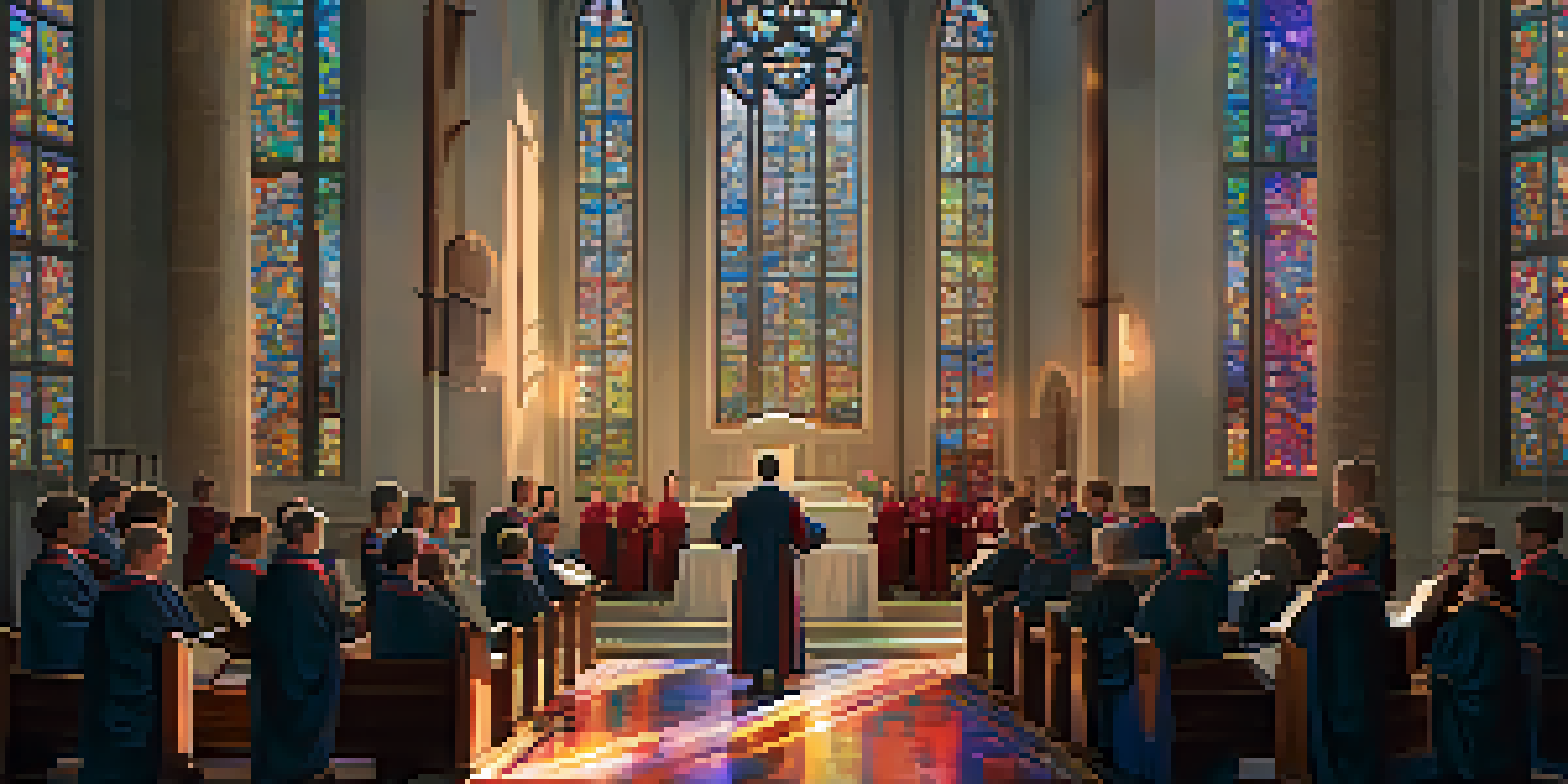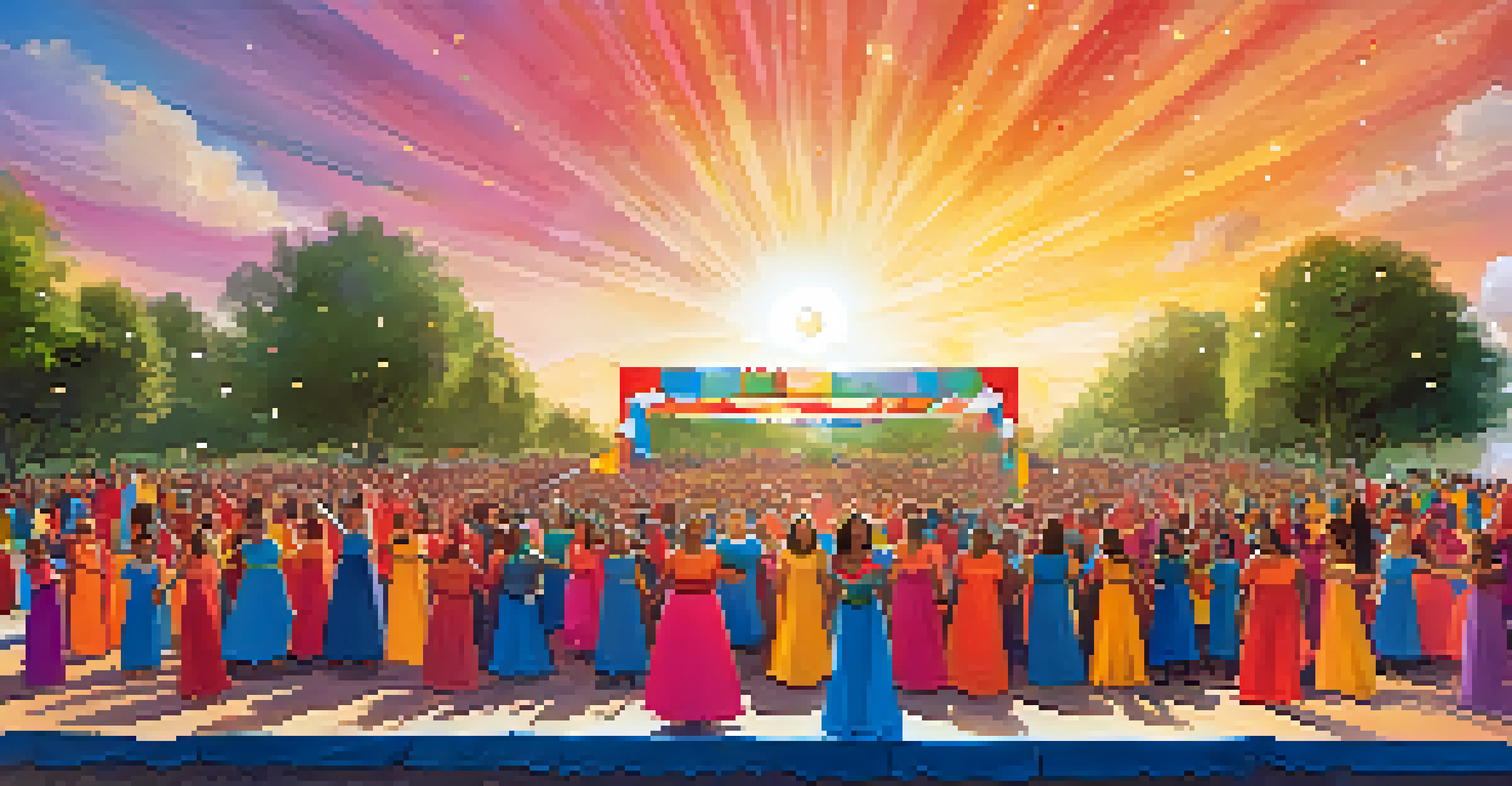Exploring Sacred vs. Secular Choral Music

Understanding Sacred Choral Music and Its Significance
Sacred choral music encompasses compositions designed for worship and spiritual reflection. It often draws from religious texts, creating an atmosphere of reverence and devotion. For example, works like Handel's 'Messiah' elevate the listener's experience with powerful lyrics and harmonies that express faith and hope.
Music is the shorthand of emotion.
The historical context of sacred music is rich, with roots tracing back to ancient traditions and liturgical practices. Composers such as Bach and Palestrina have set the benchmark for sacred music, blending theological themes with musical innovation. This tradition has influenced not only religious ceremonies but also the wider musical landscape.
In many cultures, sacred music serves as a communal experience, bringing people together in worship. The act of singing in a choir fosters a sense of unity and shared purpose among participants. This emotional connection reinforces the importance of sacred music in spiritual and communal gatherings.
Exploring Secular Choral Music and Its Appeal
Secular choral music, on the other hand, embraces themes outside of religious contexts, focusing on human experiences, emotions, and stories. This genre allows for a broader range of interpretations and styles, from folk songs to contemporary compositions. For instance, Eric Whitacre's 'Lux Aurumque' showcases a stunning blend of modern harmonies while remaining non-religious.

The versatility of secular choral music enables choirs to explore various genres and cultural expressions. This adaptability has led to the inclusion of diverse musical influences, enriching the choral repertoire. Pieces like 'The Lion Sleeps Tonight' highlight how secular music can engage audiences through familiarity and joy.
Sacred Choral Music's Spiritual Role
Sacred choral music fosters spiritual reflection and community through compositions that draw from religious texts.
Moreover, secular choral music often reflects societal themes and issues, providing a platform for artistic expression. Celebrations of love, nature, and human struggle resonate with listeners, making this genre deeply relatable. In this way, secular music not only entertains but also encourages reflection on our shared humanity.
Key Differences Between Sacred and Secular Music
One of the primary distinctions between sacred and secular choral music lies in their intent and message. Sacred music aims to inspire spiritual contemplation, while secular music often seeks to entertain or provoke thought. This fundamental difference shapes the composition, performance, and reception of each style.
The only thing better than singing is more singing.
Musically, sacred music often adheres to traditional structures, utilizing forms such as hymns or anthems. In contrast, secular music tends to be more experimental, incorporating various genres and styles. This flexibility allows secular compositions to resonate with a modern audience, reflecting contemporary themes and cultural shifts.
Additionally, the performance settings for sacred and secular music can differ significantly. Sacred music is frequently performed in places of worship, creating a sacred atmosphere. Secular music, however, thrives in a variety of venues, from concert halls to community festivals, making it more accessible to diverse audiences.
The Role of Text in Sacred and Secular Music
Text plays a crucial role in both sacred and secular choral music, but the nature of the message varies widely. Sacred texts are often derived from religious scriptures, aiming to convey spiritual truths and teachings. This focus on divine themes fosters a sense of reverence and connection to the divine.
In contrast, secular choral music often uses poetry or lyrics that explore universal themes such as love, loss, and joy. This allows composers to connect with the audience on a personal level, inviting them to reflect on their own experiences. For instance, a choral setting of a poem may evoke nostalgia or happiness without any religious connotations.
Secular Music's Cultural Resonance
Secular choral music reflects human experiences and societal themes, making it relatable and engaging for diverse audiences.
The relationship between music and text in both genres also shapes the emotional impact of the performance. In sacred music, the music often elevates the text, creating an ethereal experience. Meanwhile, in secular music, the interplay between melody and lyrics fosters a sense of relatability and emotional engagement.
Cultural Influences on Sacred Choral Music
Cultural influences have profoundly shaped sacred choral music throughout history. Different religious traditions bring unique musical elements, resulting in diverse styles and practices. For example, the Gregorian chant from the Catholic Church offers a stark contrast to the vibrant choral traditions found in African American churches.
As societies evolve, so do their musical expressions of faith. Contemporary sacred music often incorporates modern influences, merging traditional hymns with popular music styles. This fusion not only keeps sacred music relevant but also attracts younger generations to worship.
Moreover, cultural contexts can dictate how sacred music is performed and experienced. In some cultures, singing in worship is a communal act filled with exuberance, while in others, it may be more subdued and reflective. These variations enrich the global landscape of sacred music, showcasing its adaptability and depth.
Cultural Influences on Secular Choral Music
Secular choral music is also deeply influenced by cultural trends and societal changes. As music reflects the zeitgeist, composers often draw inspiration from current events and popular culture. This responsiveness allows secular music to resonate with audiences, making it a powerful form of expression.
For instance, the rise of social movements has spawned a wealth of choral compositions that address issues like equality and justice. Pieces that tackle these themes encourage choirs to engage with their communities and spark conversations. This connection between music and societal issues enhances the relevance of secular choral music.
Future Trends in Choral Music
The future of choral music lies in blending sacred and secular elements, enhancing its ability to connect people across various backgrounds.
Additionally, cultural diversity enriches secular choral repertoires, with choirs performing works that celebrate various traditions. From Latin American folk songs to contemporary pop arrangements, the breadth of secular music allows for inclusivity and exploration. This variety not only captivates audiences but also fosters cultural appreciation among performers and listeners alike.
The Future of Sacred and Secular Choral Music
As we look to the future, both sacred and secular choral music continue to evolve, adapting to societal changes and technological advancements. The rise of digital platforms has made choral music more accessible, allowing diverse voices to be heard. This democratization of music creates opportunities for new compositions and collaborations.
One exciting trend is the blending of sacred and secular elements within choral works. Composers are increasingly exploring themes that bridge these two worlds, creating pieces that resonate with both spiritual and earthly experiences. This fusion not only enriches the repertoire but also fosters a deeper understanding of the human experience.

Ultimately, the future of choral music lies in its ability to connect people across different backgrounds and beliefs. Whether sacred or secular, choral music has the power to evoke emotions and inspire change. As choirs continue to innovate and engage with their communities, the richness of choral music will undoubtedly thrive.